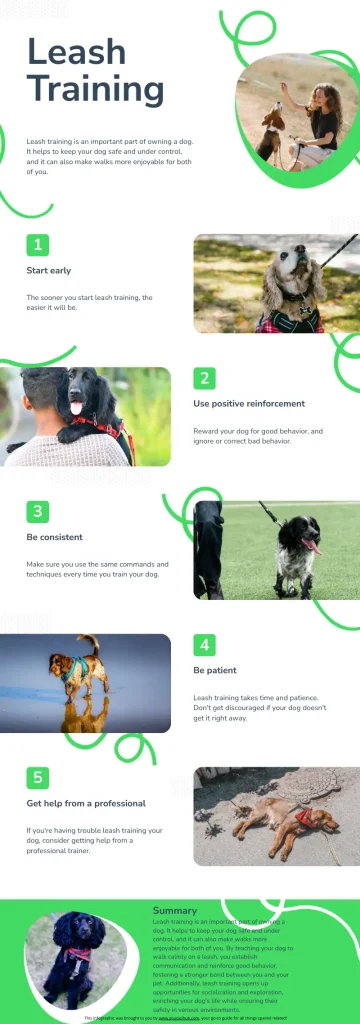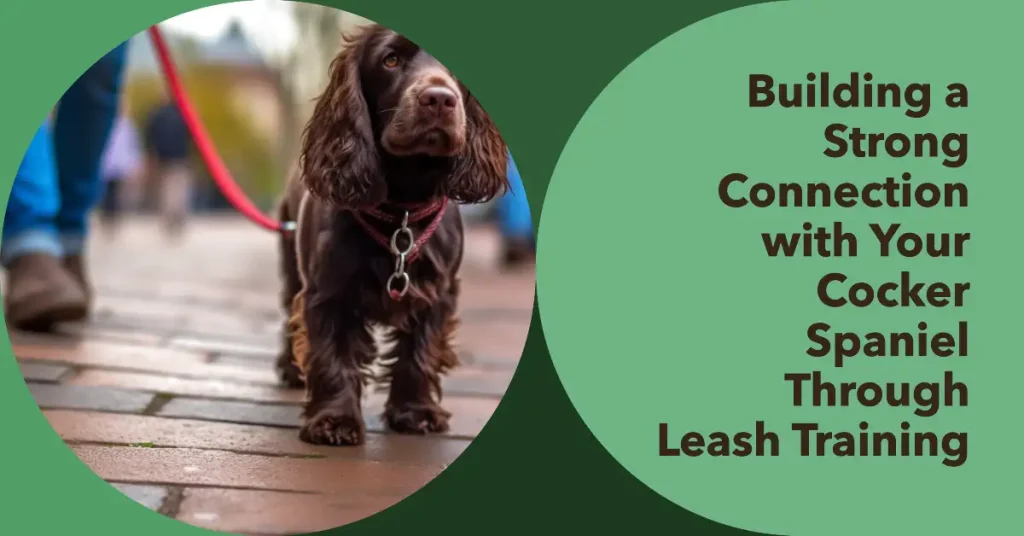Table of Contents
Cocker Spaniels are known for their cheerful disposition and boundless energy, making them a delightful addition to any family. However, their spirited nature can sometimes pose challenges, especially when it comes to leash training. Proper cocker spaniel leash training is essential for ensuring safe and enjoyable walks for both you and your furry friend.
Leash training not only establishes boundaries but also strengthens the bond between you and your Cocker Spaniel. With the right approach, patience, and consistency, you can transform your walks into a harmonious experience. In this guide, we’ll explore effective techniques and strategies to help your Cocker Spaniel become a well-mannered walker.
Understanding Your Cocker Spaniel
Cocker Spaniels are delightful companions, known for their affectionate nature and lively spirit. To effectively train them, it’s important to understand their unique traits and needs.
Behavior Traits
Cocker Spaniels are intelligent and eager to please, making them relatively easy to train. However, their curiosity and enthusiasm can sometimes lead to challenges, especially during leash training. They thrive on interaction and enjoy being part of family activities.
Energy Levels and Exercise Needs
These dogs have a high energy level and require regular exercise to stay happy and healthy. Daily walks and playtime are essential to prevent boredom and destructive behavior. Cocker spaniel leash training becomes crucial to channel their energy positively and ensure they get the exercise they need.
Instincts and Tendencies
Originally bred as hunting dogs, Cocker Spaniels have a strong instinct to chase and explore. This can lead to pulling on the leash if not addressed early on. Understanding these instincts helps in developing a training plan that satisfies their natural urges while teaching them to walk calmly by your side.
Choosing the Right Equipment
Selecting the right gear is essential for successful cocker spaniel leash training. The proper equipment ensures both comfort and control during walks.
Types of Leashes
A standard leash, typically 4 to 6 feet long, offers control while allowing some freedom of movement. It’s ideal for everyday walks and basic training. On the other hand, a retractable leash provides adjustable length but can encourage pulling, making it more suitable for well-trained dogs. A training leash, shorter in length, allows for better control and is useful for teaching commands and managing behavior effectively.
Types of Collars
The flat collar is a basic and comfortable choice for everyday use, perfect for ID tags and quick walks. A martingale collar offers more control without choking, making it ideal for dogs prone to slipping out of collars. Harnesses distribute pressure evenly, reducing neck strain and are particularly useful for dogs that pull or have respiratory issues, encouraging proper walking behavior.
Recommendations for Cocker Spaniels
For cocker spaniel leash training, using a standard leash combined with a harness is often recommended. The harness helps manage their enthusiastic nature and prevents neck strain, while the standard leash provides the control needed for effective guidance.

Step-by-Step Leash Training Guide
Training your Cocker Spaniel to walk on a leash requires patience and consistency. Here’s a detailed approach to make the process smooth and effective.
Start Indoors
Begin by introducing your Cocker Spaniel to the leash in a familiar indoor setting. Let them wear it around the house to become accustomed to the sensation. Allow them to explore freely, ensuring they associate the leash with a safe and comfortable environment. This initial step helps reduce anxiety and builds confidence.
Master Basic Commands
Teaching basic commands such as “sit,” “stay,” and “heel” is crucial. Use positive reinforcement techniques like treats and praise to encourage compliance. Practice these commands regularly, ensuring your dog responds reliably. Mastering these commands indoors sets a solid foundation for outdoor training.
Gradual Introduction to Outdoors
Once your dog is comfortable with the leash indoors, gradually transition to outdoor environments. Start in a quiet, familiar area to minimize distractions. Keep the initial walks short, focusing on reinforcing positive behavior. Gradually increase the duration and complexity of the walks as your Spaniel becomes more confident and responsive.
Common Challenges and Solutions
Leash training can present several challenges, but with patience and the right strategies, these can be effectively managed.
Dealing with Pulling
Cocker Spaniels are naturally curious and may pull on the leash. To address this, try the “stop and go” method. When your dog pulls, stop walking and wait until they return to your side. Once they do, reward them with praise or a treat and continue walking. This technique helps them understand that pulling doesn’t get them where they want to go.
Handling Distractions
Spaniels can be easily distracted by scents and sights. Start training in low-distraction environments to help them focus. Gradually introduce more distractions as your dog’s focus improves. High-value treats or favorite toys can be used to maintain their attention and reinforce their training.
Maintaining Consistency
Consistency is crucial in training. Ensure that everyone who walks your dog uses the same commands and techniques. This helps your Spaniel understand expectations and reinforces positive behavior. Regular practice and consistent reinforcement are key to successful leash training.

Positive Reinforcement Techniques
Positive reinforcement is a powerful tool in cocker spaniel leash training. It encourages desired behaviors through rewards and praise, making the learning process enjoyable for your dog.
Using Treats and Praise
When your Cocker Spaniel walks calmly beside you, immediately reward them with treats and verbal praise. This positive association helps them understand that good behavior leads to enjoyable outcomes. Select small, tasty treats that are easy to carry during walks, and use enthusiastic praise to reinforce their actions.
Timing and Consistency
The timing of rewards is crucial to effective training. Offer treats immediately after the desired behavior to reinforce the connection between the action and the reward. Consistency is key; ensure that you reward your Spaniel every time they display the correct behavior, particularly in the early stages of training. This helps solidify their understanding of what is expected.
Building a Positive Routine
Incorporate positive reinforcement into your daily routine to make leash training a consistent part of your dog’s life. Regular practice sessions help reinforce learning and gradually build your Spaniel’s confidence and discipline.
Advanced Training Tips
Once your Cocker Spaniel has mastered the basics, you can introduce more advanced techniques to enhance their leash skills and adaptability.
Increasing Duration and Distance
Gradually extend the length and duration of your walks. This helps build your Spaniel’s endurance and reinforces their training in varied environments. Begin with small increments, ensuring they remain focused and comfortable. This gradual increase helps prevent fatigue and keeps the experience positive.
Training in Different Environments
Expose your dog to a variety of settings with increasing levels of distractions. Practice in parks, urban areas, and other safe locations. This variation helps them generalize their training and adapt to new situations. Encouraging them to focus in diverse environments strengthens their obedience and confidence.
Incorporating New Commands
Introduce commands like “leave it” or “wait” to further develop their obedience. Use positive reinforcement to encourage quick responses and maintain engagement. Practicing these commands during walks enhances their listening skills and ensures safety in potentially distracting situations.

Maintaining Good Leash Behavior
Ensuring your Cocker Spaniel continues to follow leash training requires ongoing practice and attention.
Regular Practice and Reinforcement
Consistent practice is key to maintaining good leash behavior. Incorporate training into your daily routine, reinforcing positive behaviors with treats and praise. Regular walks with varied routes help keep your Spaniel engaged and responsive. Introducing new locations and challenges can also stimulate their interest and prevent boredom.
Monitoring for Regression
Be attentive to any signs of regression in behavior. If your dog starts pulling or showing less focus, revisit basic training steps. Reinforce commands like “heel” and “sit,” ensuring consistent application of techniques across all handlers. Addressing these issues early prevents bad habits from forming and maintains the progress you’ve made.
Conclusion
Leash training your Cocker Spaniel can be a rewarding journey that strengthens your bond and enhances your walks together. By understanding their behavior, choosing the right equipment, and applying consistent training techniques, you’ll create a positive experience for both you and your dog. Remember to use positive reinforcement and regularly practice to maintain good behavior. With patience and dedication, your Cocker Spaniel will become a well-mannered walking companion.
Further Reading and Resources
“The Other End of the Leash” by Patricia McConnell – A well-regarded book on understanding dog behavior.
“Don’t Shoot the Dog!” by Karen Pryor – A classic on positive reinforcement training techniques.
American Kennel Club (AKC) Website – Offers detailed guides and tips on training various breeds, including Cocker Spaniels.
The Cocker Spaniel Club – Breed-specific advice and resources for training and care.
ASPCA Training Resources – Provides practical tips and techniques for leash training and behavior management.




Just got my first Cocker Spaniel, and I’m soaking up all the info I can. The leash training part hit home. We started indoors, just like the article suggested, and it’s making a difference. Still a long way to go but feeling positive. Jodie, your guide’s a lifesaver!
Hang in there, RobynS! It gets easier. Treats were a game-changer for us. Keep at it!
Great article, Jodie. I’d like to add that understanding a Cocker’s high energy needs is crucial. I recommend interactive exercises that stimulate both their body and mind. Also, incorporating training sessions into their exercise routine can greatly enhance their learning. Keep the tips coming!
so what if my cocker spaniel doesn’t like any leash I try? tried a few types already and no luck. any tips?
I’m sorry to hear you’re having trouble with leashes! Sometimes Cocker Spaniels just need a bit more time to adjust. Try introducing the leash gradually by letting them wear it around the house without holding it. Use treats and praise to create positive associations. You might also want to try a comfortable harness instead of a collar, as it can feel more natural for some dogs.
thanks, will try that!
alex_q, sometimes it’s about patience and slow introduction. Start by letting your dog wear the leash around the house without leading them. Also, a leash with a softer material might help. Don’t give up!